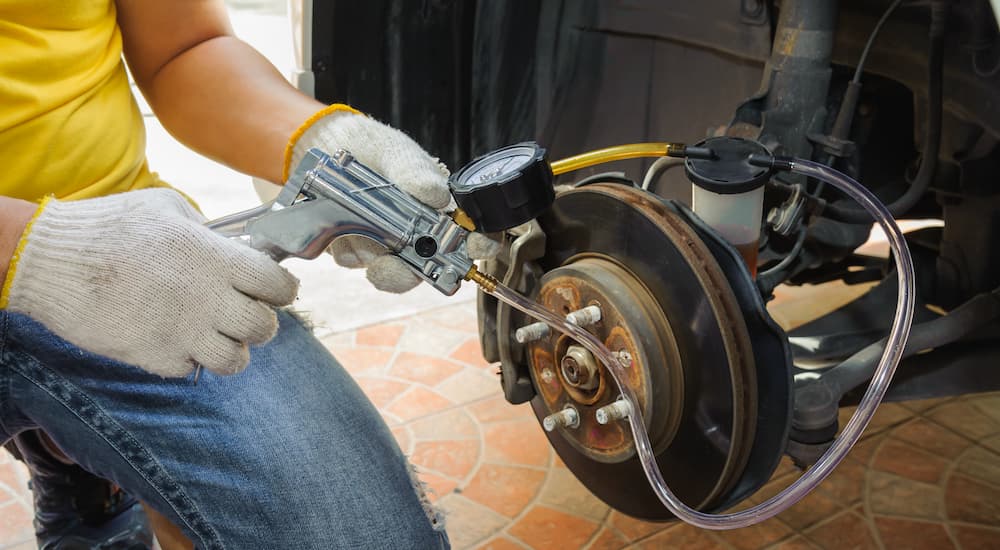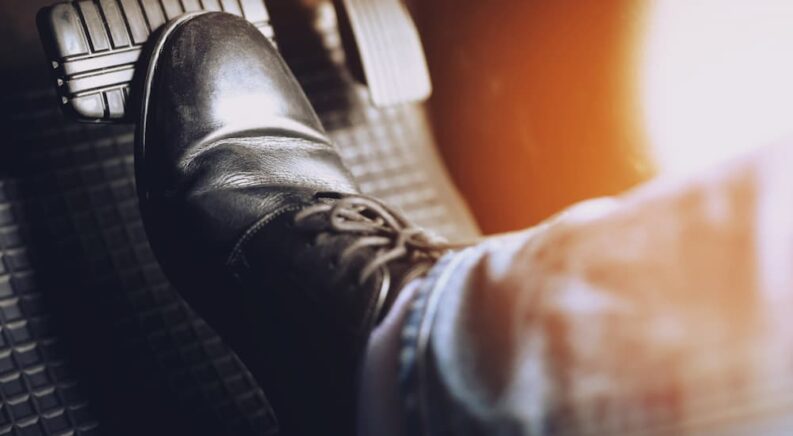Is your brake pedal no longer feeling as solid as it used to—or worse, going straight to the floor when you press on it? Then you may be overdue for a brake bleed. This process is as important as changing pads or any other brake service to keep your vehicle working its best.
However, plenty of people don’t bleed the brakes when they’re supposed to, either because they aren’t aware that it’s needed or don’t understand its significance. In that respect, let’s review everything you need to know about bleeding brakes, including why it’s necessary, when you should get it done, and different methods and tools for this task.
What Is Brake Bleeding?
Bleeding the brakes is the process required to remove air bubbles from a hydraulic system. When you bleed the brakes, you’re removing the fluid that has air pockets and replacing it with new fluid that doesn’t have any air in it.
Air can sometimes get into the brake lines, valves, and master cylinder, and when this happens, pressing on the brake pedal generates less pressure, making the pedal feel spongy and, more importantly, not working as well. When there’s too much air in the brakes, a vehicle is not safe to drive.
There are four main ways that air gets into your brake fluid:
- Water is absorbed into the system and then evaporates, leaving trapped air behind.
- The brake pads are worn out, which requires more fluid to circulate and thus leaves more space in the reservoir for air to get in.
- Fluid levels are low.
- There is a leak somewhere in the system.
A soft and unresponsive brake pedal is the main sign of air in the brakes. You can confirm this by popping the hood and pressing on the brake pedal. If this causes foam to develop in the master cylinder, then you need to do a brake bleed.

Brake Bleeding vs Brake Fluid Exchange
The process for bleeding the brakes is similar to when you’re flushing old fluid and replacing it with new fluid. However, the end goal is different. When you’re brake-bleeding, the goal isn’t to remove all the old fluid—just the fluid with air in it; some brake fluid will get flushed out, but most will remain. When you’re doing a fluid exchange, you’re bleeding the brakes over and over until every drop of old fluid is gone and replaced with new fluid.
How Often Should You Bleed Your Brakes?
Some vehicle manufacturers recommend a set schedule for brake bleeding; others do not. You will need to check the owner’s manual for more information. There are two rules of thumb you can follow for precautionary reasons. One is to bleed the brakes every time you perform another brake service, such as changing pads or rotors. The other is to do so every one or two years. Depending on the vehicle, you should fully replace the fluid every five years at most, as old fluid can cause corrosion in the system.
You can also wait and bleed the brakes whenever you detect a problem. Though this is less work and expense, it’s also potentially more dangerous. If the air in your system is due to another issue, such as a leak or worn-out pads, you will need to fix that issue before bleeding the brakes.
Can You Bleed the Brakes Yourself?
It is possible to bleed your vehicle’s brakes at home, but be aware that it can potentially be a difficult and time-consuming process. Brake bleeding also requires special equipment, and you will need to safely dispose of the old fluid.
There are four main methods for bleeding brakes. We’ll present them in order from simplest to most complex:
Gravity brake bleeding is when you open a bleeder valve and let gravity drain the fluid out into a container. Though simple, it will take the longest (an hour or more per brake caliper) and is the messiest option.
Manual brake bleeding is when you physically pump the brake pedal to force fluid out of the open bleeder valve. This is much faster than gravity bleeding but requires two people—one to hold the container and one to pump the brakes.
Pressure brake bleeding is when you use a pressurized fluid dispenser to force fluid through the master cylinder and into the system, pushing the old air-filled fluid out the bleeder valve. It is fast and only needs one person, but kits can be expensive, and you’ll need the correct adapters.
Vacuum Brake Bleeding is when you attach a vacuum pump and container to the bleeder, which draws fluid out. It is the fastest solution but usually the most expensive, though the vacuum pump may have other uses.
For each of these methods, you’ll need the following supplies:
- A hex wrench to open the screw on each bleeder valve.
- The appropriate brake fluid to replace the old fluid (typically DOT 3 or DOT 4, but check your owner’s manual).
- A jack and jack stand(s) to lift the vehicle.
- A lug wrench to remove the tires and wheels.
- A clean, chemical-resistant container for the old fluid.
- A clear hose or tube (at least 12 inches long) to place over the bleeder valve so the fluid doesn’t drip everywhere.
- Gloves and long-sleeved clothing to protect you from the fluid.
- Towels or rags to wipe up any fluid that gets on the floor.
Here are a few other notes to help you bleed the brakes:
- You will know to stop bleeding each caliper when the fluid in the tube no longer contains any air bubbles.
- If the brake fluid comes out looking discolored or contaminated, you should proceed to a full fluid exchange.
- Start with the brake bleeder valve that is farthest away from the master cylinder and work your way toward it. On most modern vehicles, it means going in this order: right rear, left rear, right front, left front.
- Top off the fluid level in the master cylinder before you start and after completing each bleeder valve.
- If there are two bleeder valve screws per caliper, do the inner/lower screw first, followed by the outer/upper screw.
- Double-check the brake pedal to be sure it’s responding correctly before you put the tires back on.

How Much Does a Brake Bleed Cost?
According to RepairPal, getting your brakes bled by a professional shop will cost between $81 and $102, depending on the location, plus any applicable taxes and fees. DIY brake bleeding kits are also available. They range from a few dollars for a basic manual brake bleed kit to $100 for vacuum kits. Some high-end kits will also help you locate leaks in the system.
Getting Your Brakes Serviced
In most cases, you should trust a professional technician for brake bleeding, especially if you are inexperienced with car care or don’t have a good place to work and store tools. Reputable technicians are trained to complete this task correctly, quickly, and safely, giving you peace of mind. You won’t need to purchase any specialized tools, either.
Final Thoughts
Brake maintenance is among the most important vehicle maintenance you can do. Keeping your hydraulic brake system in good operating condition means having air-free lines. If you are experiencing brake issues that you believe are due to air in the fluid or a related issue, immediately check the master cylinder as described or schedule an appointment at a service center.

